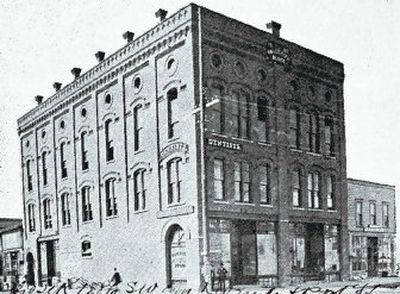The opera has left the building

This May, the Spokane Opera House officially changed its name to the INB Performing Arts Center (after sponsor Inland Northwest Bank). From a historical perspective, that calls for a resigned sigh. But not because of the usual “crass commercialism” objections.
It’s because the name “Opera House” has had a long and fascinating history in Spokane and, for that matter, throughout the entire West. In fact, the very term “Opera House” spoke volumes about the cultural aspirations of the people who settled and built Spokane and the West. Right after the churches and schools went up, an “Opera House” inevitably followed.
Yet that wasn’t because the pioneers intended to stage many (or in some cases, any) actual operas. It’s because they were afraid to call these places “theaters.”
The word “theater” had low, if not downright bawdy, connotations in America in the 1880s and 1890s. Spokane was a perfect illustration. Spokane had plenty of theaters, but most of them were “variety theaters” known less for Shakespeare than for a practice called “box-rustling.”
Box-rustling theaters employed a number of young women as dancers and barmaids. They lured miners and loggers into curtained-off boxes in the upper tiers, where they would entice them, using various age-old methods, into buying expensive rounds of drinks and who knows what else. Think of it as an old-fashioned version of the lap dance.
So if you were going to build a “legitimate” theater, the kind that staged actual plays and concerts, you certainly didn’t want to call it a “theater.”
“Managers routinely called their houses something else – usually opera house, but occasionally ‘museum’ or ‘auditorium’ or ‘academy of music’ to reassure virtuous ladies and high-minded gentlemen that attendance wouldn’t blight their prospects for salvation,” wrote J. Anthony Lukas in his book “Big Trouble,” dealing with the history of our region.
So that explains why one of the first theaters in the new city of Spokane Falls in 1882 was called “Opera House,” on the northeast corner of Riverside and Post. Despite the name, no one would have mistaken it for a La Scala-like palace of opera. It was a warehouse and the patrons sat on nail kegs, according to Robert B. Hyslop in his invaluable reference “Spokane’s Building Blocks.”
Within a year, it has been converted into a new, barnlike theater on the same corner, called Joy Opera House, managed by Harry Hayward. It hosted many different plays and concerts, and even a few operas. Its first show – and probably the first real theatrical event in Spokane – was a tour of the comic opera “The Bohemian Girl” starring Emma Abbott.
The Joy Opera House lasted until Hayward built the Falls City Opera House, with a capacity of 800, in 1887 at the southwest corner of Riverside and Post. It did not survive the great 1889 fire.
In 1890, two “opera houses” are listed in the Polk City Directory. The first was the New State Opera House, on the southwest corner of Main and Bernard, part of a complex called The Great American Resort. The words “opera house” were evidently a ruse; the place appeared to be more of a variety theater.
The second was destined to become the city’s cultural landmark until 1934: The Auditorium Opera House, on the northwest corner of Main and Post.
This theater’s high-end cultural aspirations can be measured by the fact that it combined two highfalutin terms, Auditorium and Opera House.
It truly was a palace of the performing arts: seven stories tall, topped by a conical tower, with three balconies and a capacity of 1,750. It became Spokane’s premier theater for national touring acts, such as Sarah Bernhardt, as well as spectacular touring plays such as “Ben Hur.” And true to its name, it did host some touring operas as well: Its inaugural show in 1890 was “Manon,” by the Carlton Opera Company.
The Auditorium later became the resident theater for the Maylon Players, a local repertory theater that performed a rotating series of plays on the nights when there were no touring shows.
The Auditorium later dropped the term “Opera House” from its title, but it was still careful to be listed under “Opera Houses” in the city directory, as opposed to “Theaters.”
This distinction was being made in towns all over the West, even in small farm towns such as Harrington, Wash. (present population, about 482), where the Harrington Opera House was built in 1904. This 300-capacity hall hosted minstrel shows, lectures, band concerts and hundreds of Saturday night dances. It probably never hosted an opera; a more accurate name for it would have been “Harrington Dance Hall.” But Harrington Opera House (currently being renovated) just sounded better.
And that’s probably one reason why, during Expo ‘74, the city settled on the dignified sounding name “Spokane Opera House” for its gleaming white performing arts center. Also, “Opera House” had come to be understood as a theater which could serve as either a concert hall or a Broadway-style theater, and, sure, the occasional opera if the opportunity arose.
Since 1974, it has been home to Jethro Tull concerts, Baryshnikov dance recitals, dozens of Broadway musicals and hundreds of Spokane Symphony concerts – yet only a bare handful of operatic events.
So, from a strictly literal standpoint, maybe it was time to retire the name Spokane Opera House. But you have to admit, Spokane Opera House has a more musical ring than the (clank) INB Performing Arts Center.